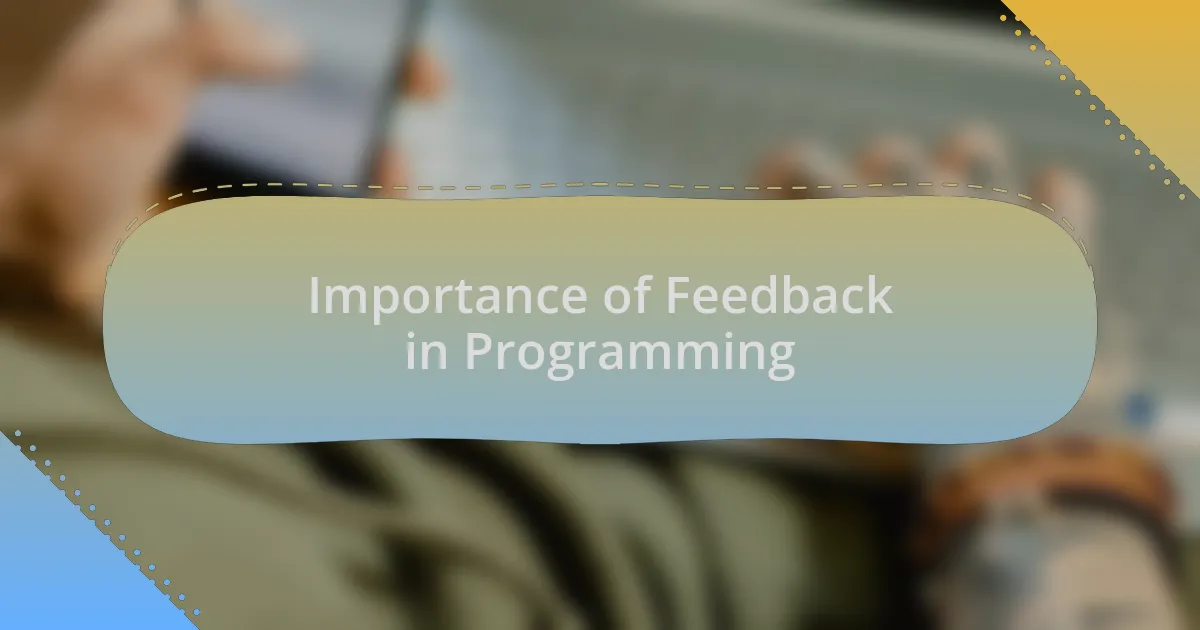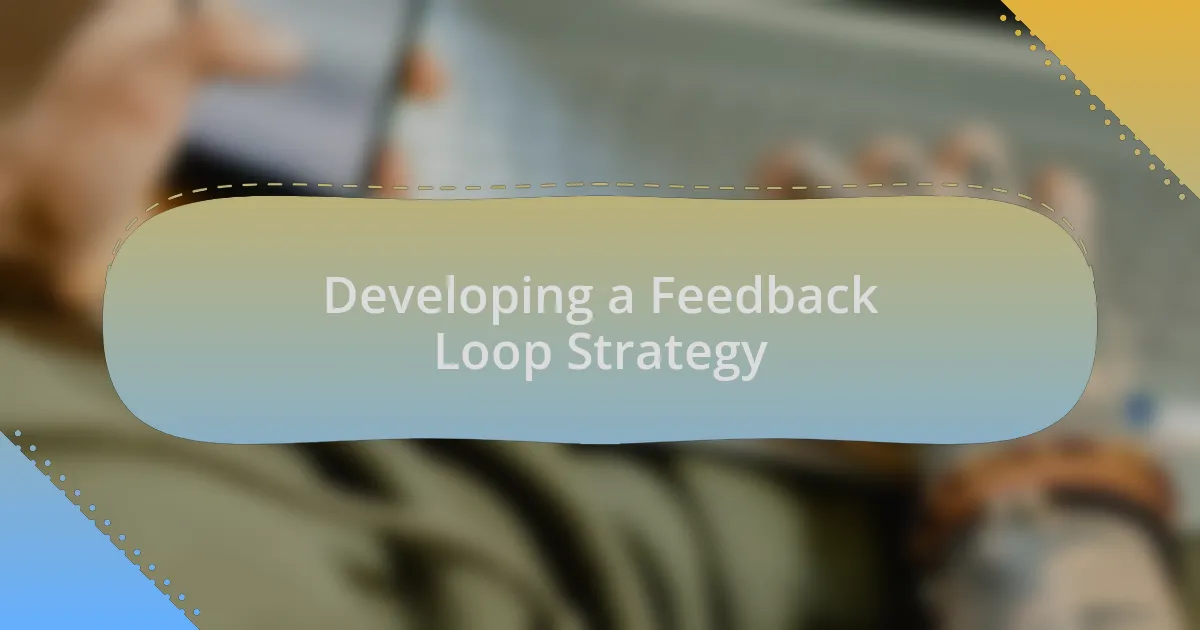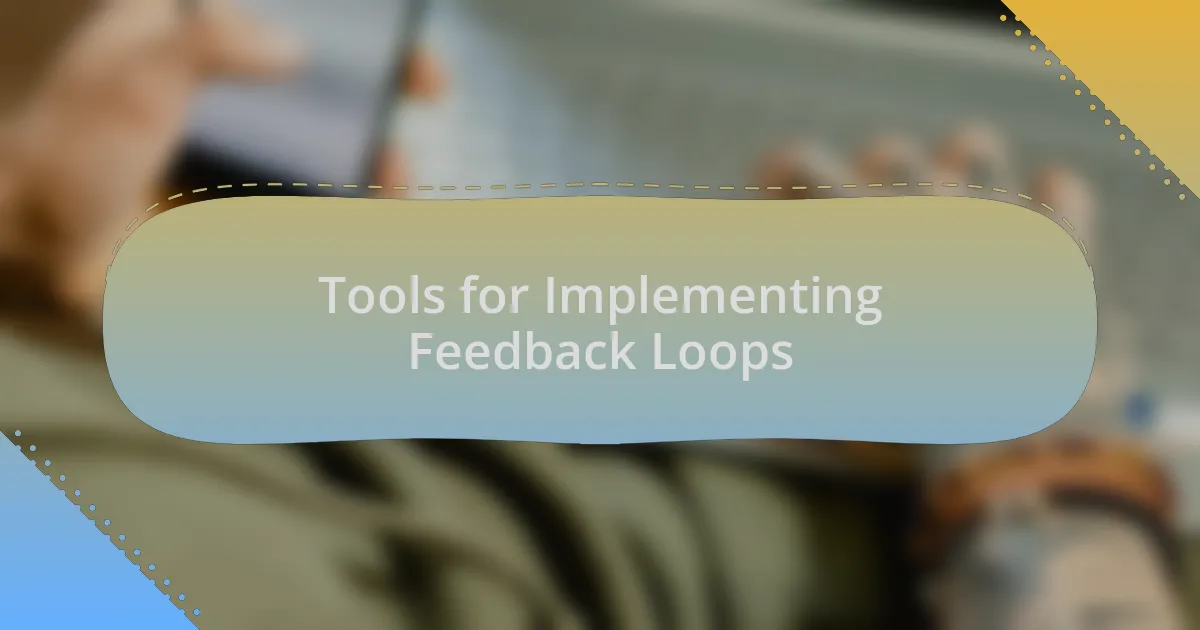Key takeaways:
- Iterative feedback loops enhance project refinement by facilitating continuous testing, user input, and improvements, creating a culture of growth.
- Effective feedback integration involves selecting key suggestions, clear communication about changes made, and maintaining thorough documentation to ensure decisions are well understood.
- Challenges in feedback, such as conflicting opinions and the emotional impact of criticism, underscore the importance of having a clear vision and criteria for evaluating input.
- Utilizing appropriate tools for gathering and managing feedback can streamline the process and foster collaboration among team members.

Understanding Iterative Feedback Loops
Iterative feedback loops are essential for refining any project, especially in programming. They involve repeatedly testing a product, collecting feedback, and making improvements based on that feedback. I remember the first time I applied this method to a project; the changes I made after receiving user input transformed the final product in ways I hadn’t anticipated.
Think about it: how often do we get it right on the first try? When I started out, my code was functional but often clunky. It was through gathering feedback and iterating on my work that I learned the importance of user experience and functionality. Each round of feedback felt like a mini-revelation, helping me see beyond my own perspective.
These loops create a dynamic where learning and evolving become part of the process. In my experience, the best outcomes emerge when I embrace feedback, viewing it not as criticism but as a collaborative tool. How can we harness iterative feedback to improve our programming projects and ultimately, our skills? It’s a question worth exploring, and the answer often lies in the willingness to listen and adapt.

Importance of Feedback in Programming
Feedback plays a pivotal role in the world of programming, serving as a reality check that aligns our projects with user needs. I recall a time when I was convinced that a particular feature was perfect, only to find out through user feedback that it was confusing to navigate. This experience reminded me that our personal biases can cloud our judgment, making outside perspectives invaluable.
Consider how quickly technology evolves—what was cutting-edge last year might feel outdated this year. By actively seeking feedback, we position ourselves to adapt and stay ahead. I remember implementing a simple suggestion from a colleague that not only streamlined the code but also significantly improved its performance. It highlighted how collaboration amplifies our abilities.
Ultimately, feedback fosters a culture of growth and innovation. Reflecting on my journey, I realize that the most profound lessons often come from those unexpected critiques. Isn’t it fascinating how each piece of feedback can illuminate a path for improvement, turning a good project into a truly exceptional one?

Developing a Feedback Loop Strategy
Developing a feedback loop strategy starts with establishing clear channels for communication. I remember when I set up a regular check-in with a group of users during a project. Their insights, especially when they were spontaneous, often led to breakthroughs I hadn’t anticipated. How often do we assume we know the users best, only to discover their reality is entirely different?
Next, it’s essential to analyze the feedback methodically. In one instance, I categorized user comments into themes and prioritized them based on frequency and impact. This simple act of organization illuminated critical areas for improvement, enabling me to focus my efforts where they mattered most. Have you ever felt overwhelmed by feedback? Structuring it can transform chaos into clarity.
Lastly, you need to be flexible in adjusting your approach based on what you learn. I once integrated a feature that didn’t resonate with users at all, and instead of persevering, I pivoted based on their responses, leading to a more engaging product. After all, isn’t the ability to adapt—and even embrace change—the hallmark of successful programming?

Tools for Implementing Feedback Loops
Choosing the right tools is crucial for effectively implementing feedback loops in any project. I personally found that using dedicated survey platforms like SurveyMonkey helped me gather targeted insights from users. The ability to customize questions made it easy to hone in on specific areas for improvement—how often do we miss the mark because we’re not asking the right questions?
Collaboration tools such as Trello or Asana can be game-changers when it comes to tracking feedback and managing iterations. I remember a project where I created a feedback board, allowing team members to add comments and prioritize issues. This facilitated real-time discussions, turning ambiguous feedback into actionable tasks. Have you ever wished for a more organized way to manage multiple opinions? These tools can truly transform chaos into direction.
For those looking for a more qualitative approach, I highly recommend using tools like Miro for brainstorming sessions. I had the chance to visually map out user feedback during a team workshop, and it was an enlightening experience. Watching thoughts morph into clear action items in real-time motivated us all to be more innovative. Isn’t it amazing how visual representation can spark creativity and facilitate deeper understanding?

Personal Experiences with Feedback Loops
Feedback loops have played a pivotal role in my growth as a programmer. Early on, I developed a habit of seeking input after every project phase, and I vividly recall a case where a colleague pointed out a crucial usability issue that I had overlooked. It was a humbling experience, but it reinforced the importance of continuous feedback—it’s not just about creating software; it’s about creating something that truly resonates with users.
One project stands out when I think about integrating feedback loops: a web application I developed for tracking fitness goals. After launching the beta version, I directly reached out to users for their thoughts. The insights were eye-opening! Some of their suggestions led to unexpected features that ultimately changed the app’s direction. This made me wonder—how many features in our projects are ignored simply because we don’t actively seek user perspectives?
To further my understanding, I started documenting the feedback process more systematically. By analyzing the comments and suggestions over time, I recognized patterns in user behavior. This data-driven approach helped sharpen my instincts about what users valued most. It’s fascinating how gathering and reflecting on feedback not only enhanced the products I built but also enriched my skills as a developer. Have you ever paused to see how feedback could shape your future projects? It might just be the key to unlocking new possibilities.

Common Challenges in Iterative Feedback
One of the most common challenges I encountered with iterative feedback is managing conflicting opinions from users. There was a time when multiple beta testers each had different perspectives on a feature I designed. Trying to accommodate everyone felt overwhelming, and I found myself questioning which suggestions to prioritize. It made me realize how important it is to establish a clear vision and criteria for evaluating feedback before diving into the implementation.
Another notable hurdle has been the emotional weight of criticism. I remember a review that pointed out flaws in a particularly designed interface I was proud of. Initially, it stung. However, I learned that resisting the urge to take it personally allows me to extract more valuable lessons from critiques. What I found most rewarding was when I changed my mindset from viewing feedback as a setback to seeing it as a stepping stone towards improvement.
Finally, timing often presents its own challenges. Gathering feedback too early might lead to changes based on half-formed ideas, while waiting too long may leave users disenchanted. I once faced a project where I hesitated to solicit feedback, thinking the product was “almost perfect.” But when I finally did reach out, users’ responses uncovered critical flaws that I had missed. How do you determine the right time to ask for input? It’s a delicate dance, but one that can redefine the trajectory of your project.

Tips for Effective Feedback Integration
When integrating feedback, I’ve found it crucial to be selective. After a recent user testing session, I was inundated with suggestions that ranged from minor tweaks to major overhauls. Rather than implementing every idea, I focused on patterns in the feedback. What are the recurring themes? This method allows me to prioritize changes that genuinely enhance the user experience.
Communication plays a significant role in how feedback is perceived and acted upon. I recall a time when I shared an interim update with my team after incorporating suggestions. While I was excited about the changes, I noticed how important it was to clearly explain why certain ideas were included, while others weren’t. Did I miss out on something valuable? Addressing these concerns helped create a more constructive environment, fostering trust and collaboration.
Documentation is another essential tip that often gets overlooked. Each time I make changes based on feedback, I document the rationale behind those decisions. I once neglected this step and found myself questioning my past choices later. How can I defend my design if I don’t remember why I made those decisions? Keeping clear records not only elucidates my thought process for myself but can also be useful in future iterations, making it easier to reflect on learned lessons.